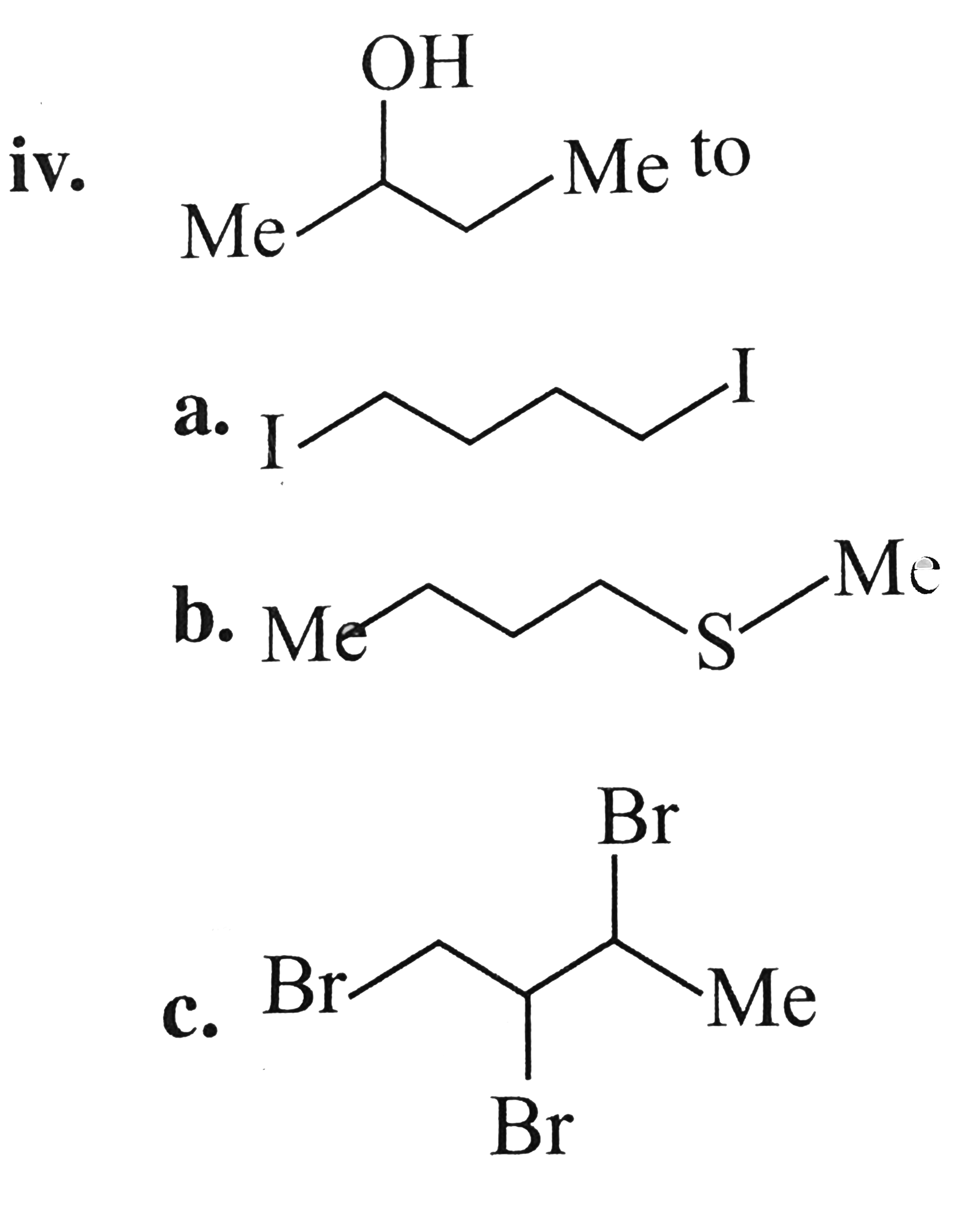Explain :
a. Vinyl chloride is unreactive in nucliphillic 4− subsitution reactions.
b. Neopenthyl bromide undergoes nucliphillic substituion reactions very slowly.
c. 3− Bromocyclohexane is more reactive than 4− bromovyclohexane in hydrolysis with aqueous NaOH.
d. ter− Butyl chloride reacts with aqueous sodium hydroxide by SN1 mechanishm while n− butuyl chloride reacts by SN2 medchanism.
a. Vinylic and aryl halides are unreactive towards SN reactions due to the resonance effects. Resonanace gives rise to partial double bond character to the (C−X) bond, making stonger and, therefore more diffcult to cleave than the (c−X) bond in RX(Rsp3−X) bond. It also reduces te polarity of the (cX) bond and, therefore, the heterolytic cleavage of (C−X) bond is difficult.

Neopentyl bromide gies (1∘C⊕) which can rearrange to 3∘C⊕ by 1.2, methyl shift, but is sterically hindered and so SN reaction takes place slowly.
C. 
(i) gives allylic carbocation, while (ii) gives 2∘C⊕ and allylic C⊕ is more stable than 2∘C⊕. So (i) more reactive than (ii) in hydrolysis with aq. NAOH.

ii. CH3CH2CH2CH2Cl→CH3CH2CH2(1∘C⊕)⊕CH2
Reactivity of SN1 reaction is 3∘C⊕>2∘C⊕>1∘C⊕ and reactivity of SN2 reaction is 1∘C⊕>2∘C⊕>3∘C⊕ . So (i) reacts with aq. NaOH by SN1 mechanism because it gives 3∘C⊕, while (ii) undergoes by SN2 reaction becuase it gives 1∘C⊕, ions.
Related Playlists
- BOOK - CENGAGE CHEMISTRYCHAPTER - AROMATIC COMPOUNDS AND ALKYL AND ARYL HALIDES EXERCISE - Exercises Subjective Type4videos
AROMATIC COMPOUNDS AND ALKYL AND ARYL HALIDES
- BOOK - CENGAGE CHEMISTRYCHAPTER - AROMATIC COMPOUNDS AND ALKYL AND ARYL HALIDES EXERCISE - Exercises Subjective17videos
AROMATIC COMPOUNDS AND ALKYL AND ARYL HALIDES
- BOOK - CENGAGE CHEMISTRYCHAPTER - AROMATIC COMPOUNDS AND ALKYL AND ARYL HALIDES EXERCISE - Solved Examples21videos
AROMATIC COMPOUNDS AND ALKYL AND ARYL HALIDES
- BOOK - CENGAGE CHEMISTRYCHAPTER - APPENDIX INORGANIC VOLUME 2EXERCISE - Short Answer Type179videos
APPENDIX INORGANIC VOLUME 2
- BOOK - CENGAGE CHEMISTRYCHAPTER - BIOMOLECULESEXERCISE - Exercises Archives (Analytical And Descriptive)8videos
BIOMOLECULES
Similar Questions
Synthesise the following:
i. Propane to a. 1− fluroopropane, b. cyclopropane, and c. 2.3− dunethl butane
ii.
iii. C2H5Br to but −1− ene
iv.
v. CYclopetane ro hexachloropentadience
(vi) Cyclopentadiene + Hexachlorocyclopentadiene
 02:46View Solution
02:46View SolutionGive the chemical test to distinguish between
(a) Hexane (I), MeCH=CHCl(II),
Propylchloride (III), and CH2=CHCH2Cl(IV)
(b) (V)CH3Cl, (VI) CH_(3)Br,and(VII) CH_(3)I02:53View SolutionBenzene, touene, xylene (o,m,p) and mesitylene dissolve in HBF4 to from salts. Expalin the order of basicity:
Mesitylene >m−Xylene>o− and p− Xylenen gt Toulene gt Benzene02:28View SolutionWhich metals are generally extracted by the electrolytic processes ? What positions these metals generally occupy in the periodic table?
07:20View SolutionWrite the structure of alanine at pH=2andpH=10.
16:50View Solution(A) Ethyl chloride is more reactive than vinyl chloride towards nucleophilic substitution reaction .
(R) In vinyl chloride the -CI is bonded to sp-hybridized carbon of an alkene.03:22View Solution(A) Ethyl chloride is more reactive than vinyl chloride towards nucleophilic substitution reactions. (R) Vinyl chloride is +I electron pushing group.
01:36View SolutionThe nucliphilic substituation of primary alkyl chlorides wityh sodium acetate is cataysed by sodium iodide. Explain why.
View Solutionतब क्या होता है जब -
(i) n - ब्यूटिल क्लोराइड को ऐलकोहॉलिक KOH के साथ अभिक्रिया कराया जाता है
(ii) शुष्क ईथर की उपस्थिति में ब्रोमोबेन्जीन की अभिक्रिया मेग्नेशियम से होती है
(iii) क्लोरोबेंज़ीन का जलअपघटन कीजिये ?
(iv) एथिल क्लोराइड की अभिक्रिया जलीय KOH से होती है
(v) शुष्क ईथर की उपस्थिति में मैथिल ब्रोमाइड की अभिक्रिया सोडियम से होती है
(vi) मैथिल क्लोराइड की अभिक्रिया KCN से होती है03:24View Solutionकारण सहित व्याख्या कीजिए -
(i) क्लोरोबैंजीन का द्विध्रुव आधूर्ण साइक्लोहेक्सिल क्लोराइड की तुलना मे कम होता है ।
(ii) ऐल्किल हैलाइड ध्रुवीय होते हुए भी जल मे अविलेय हैं ।
(iii) विनाइल क्लोराइड न्यूक्लियोफिलिक प्रतिस्थापन अभिक्रियाओं के प्रति अक्रियाशील है ।
(iv) नियोपेंटिल ब्रोमाइड धीमी गति से न्यूक्लियोफिलिक प्रतिस्थापन अभिक्रियाएँ देता है ।
(v) जलीय NaOH के साथ जल अपघटन क्रिया मे 4-ब्रोमोसाइक्लोहेक्सिन की तुलना मे 3-ब्रोमोसाइक्लोहेक्सिन अधिक क्रियाशील है ।
(vi) टर्श-ब्यूटिल ब्रोमाइड जलीय सोडियम हाइड्राक्साइड के साथ SN1 क्रियाविधि के द्वारा क्रिया करता है जबकि n-ब्यूटिल क्लोराइड SN2 क्रियाविधि द्वारा क्रिया करता है ।
(vii) ग्रिगनार्ड अभिकर्मक का निर्माण अनार्द्र (शुष्क) परिस्थितियों मे करना चाहिए ।01:43View SolutionReaction of tert-butyl bromide with aqueous sodium hydroxide follow
View SolutionBenzenamine reacts with benzoyl chloride in presence of aqueous sodium hydroxide to form_____and the reaction is called____reaction.
View SolutionAccount for the following: t-butyl chloride reacts with aqueous KOH by SN1 mechanism while n-butyl chloride reacts with SN2 mechanism.
View SolutionVinyl chloride and chlorobenzene are unreactive in SN2 reaction. Explain these observations.
03:50View SolutionExplain why vinyl chloride is unreactive in nucleophillic substitution reaction?
10:16View Solution

